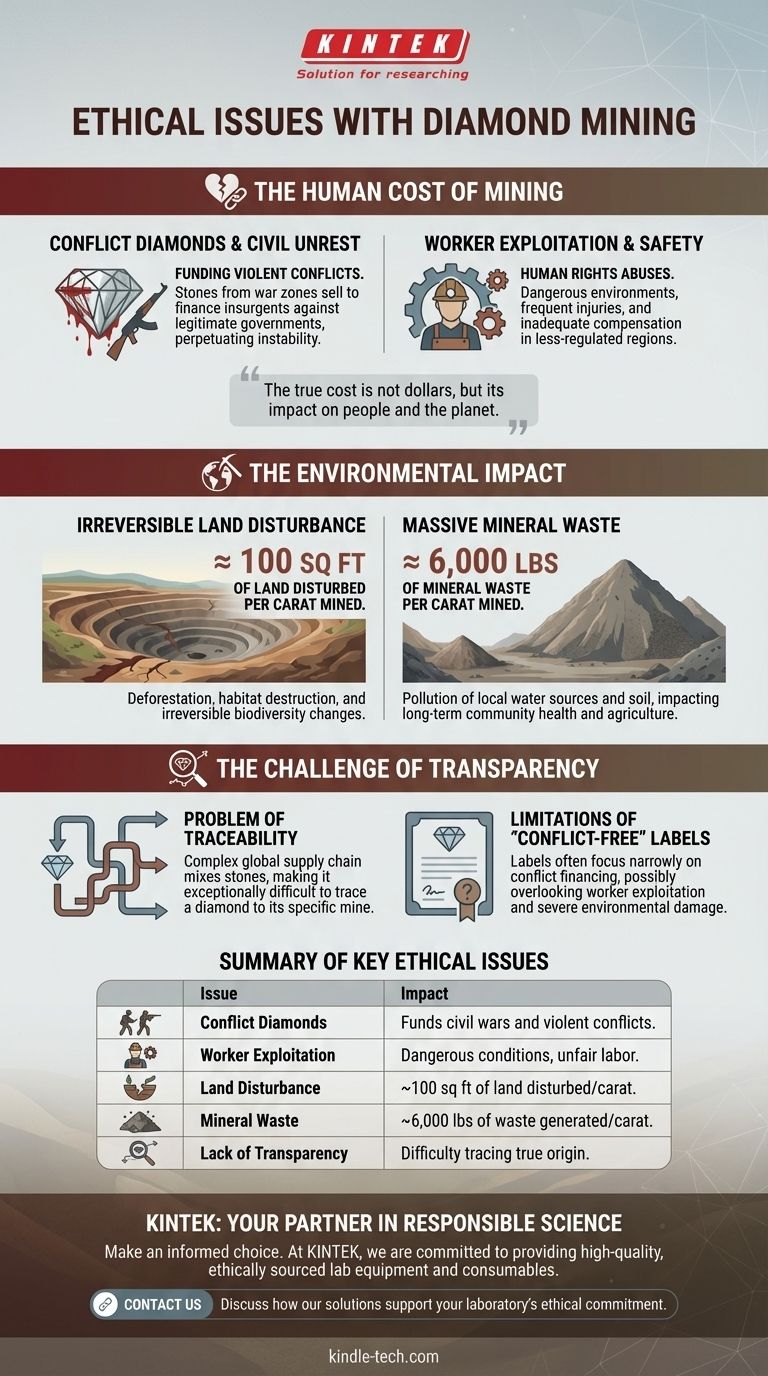At its core, the ethical problem with diamond mining is a profound conflict between a luxury good and the severe human and environmental costs required to extract it. Major issues include severe human rights abuses, including the funding of violent civil conflicts, and irreversible ecological damage caused by destructive mining practices.
The true cost of a traditionally mined diamond is not measured in dollars, but in its impact on people and the planet. The central ethical dilemma lies in a supply chain historically plagued by worker exploitation, violent conflict, and significant environmental destruction.

The Human Cost of Diamond Extraction
The journey of a diamond from the earth to a display case is often fraught with serious human rights issues that are difficult for the end consumer to see.
Conflict Diamonds and Civil Unrest
A significant ethical issue is the existence of “conflict diamonds,” also known as “blood diamonds.” These are stones mined in war zones and sold illegally by insurgent or rebel groups.
The proceeds from these sales are used to fund civil wars and violent conflicts against legitimate governments, perpetuating instability and suffering.
Worker Exploitation and Safety
Beyond overt conflict, the daily conditions for many mine workers raise serious ethical concerns. The industry has been linked to severe human-rights violations.
This includes dangerous working environments that lead to frequent injuries, inadequate compensation, and other forms of labor exploitation in less-regulated mining regions.
The Environmental Impact of Mining
The physical act of pulling a diamond from the ground is an aggressive process that causes lasting harm to local ecosystems.
Irreversible Land Disturbance
Diamond mining requires moving massive quantities of earth. For every single carat of diamond extracted, miners disturb nearly 100 square feet of land.
This disruption leads to soil erosion, deforestation, and the destruction of natural habitats for local wildlife, causing what experts call irreversible changes to biodiversity.
Massive Mineral Waste
The process is also incredibly inefficient. Extracting that one carat of diamond generates almost 6,000 pounds of mineral waste.
This waste can pollute local water sources and soil, impacting the health and agricultural viability of the surrounding communities long after a mine has closed.
The Challenge of True Transparency
Even for consumers who want to make an ethical choice, the nature of the diamond market presents significant obstacles.
The Problem of Traceability
Once a rough diamond is extracted, it enters a complex global supply chain where it is often mixed with stones from many other sources. This makes tracing a single diamond back to its specific mine of origin exceptionally difficult.
Without a clear and verifiable chain of custody, it's challenging to guarantee that a diamond is free from the ethical issues that plague the industry.
Limitations of "Conflict-Free" Labels
While certification systems exist to label diamonds as "conflict-free," these labels often focus narrowly on preventing the financing of rebel groups.
They may not account for other critical ethical concerns, such as worker exploitation, fair wages, safe working conditions, or the severe environmental damage caused by the mining operation.
Making an Informed Decision
Understanding these issues is the first step toward responsible consumerism. When evaluating a traditionally mined diamond, your priorities will guide your questions.
- If your primary focus is avoiding conflict financing: Demand to see robust documentation that traces the diamond's origin, but remain aware of the inherent traceability challenges in the global market.
- If your primary focus is minimizing environmental impact: Recognize that significant land disturbance and mineral waste are fundamental byproducts of nearly all traditional diamond mining operations.
Ultimately, asking critical questions about a diamond's journey is essential to understanding its true ethical and environmental cost.
Summary Table:
| Ethical Issue | Key Impact |
|---|---|
| Conflict Diamonds | Funds civil wars and violent conflicts. |
| Worker Exploitation | Dangerous conditions and unfair labor practices. |
| Land Disturbance | ~100 sq ft of land disturbed per carat mined. |
| Mineral Waste | ~6,000 lbs of waste generated per carat mined. |
| Lack of Transparency | Difficulty tracing a diamond's true origin. |
Make an informed choice for your laboratory. The ethical sourcing of materials is a cornerstone of responsible research. At KINTEK, we are committed to providing high-quality, ethically sourced lab equipment and consumables that meet the highest standards of sustainability and transparency.
Contact us today to discuss how our solutions can support your laboratory's commitment to ethical practices. Get in touch via our contact form and let KINTEK be your trusted partner in responsible science.
Visual Guide

Related Products
- CVD Diamond Cutting Tool Blanks for Precision Machining
- CVD Diamond Optical Windows for Lab Applications
- Custom CVD Diamond Coating for Lab Applications
- CVD Diamond for Thermal Management Applications
- High Precision Diamond Wire Cutting Machine Laboratory Saw Precision Wire EDM Cutting Machine
People Also Ask
- Why is diamond used for making or coating tool? Unlock Unmatched Hardness and Precision
- What is the hardness of CVD diamond? The Ultimate Guide to Engineered Super-Materials
- What are the raw materials for CVD diamonds? A seed, a gas, and the science of crystal growth.
- What is the carbon footprint of diamond mining? Uncovering the True Environmental and Ethical Cost
- How is something diamond coated? A Guide to CVD Growth vs. Plating Methods











